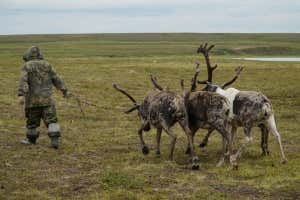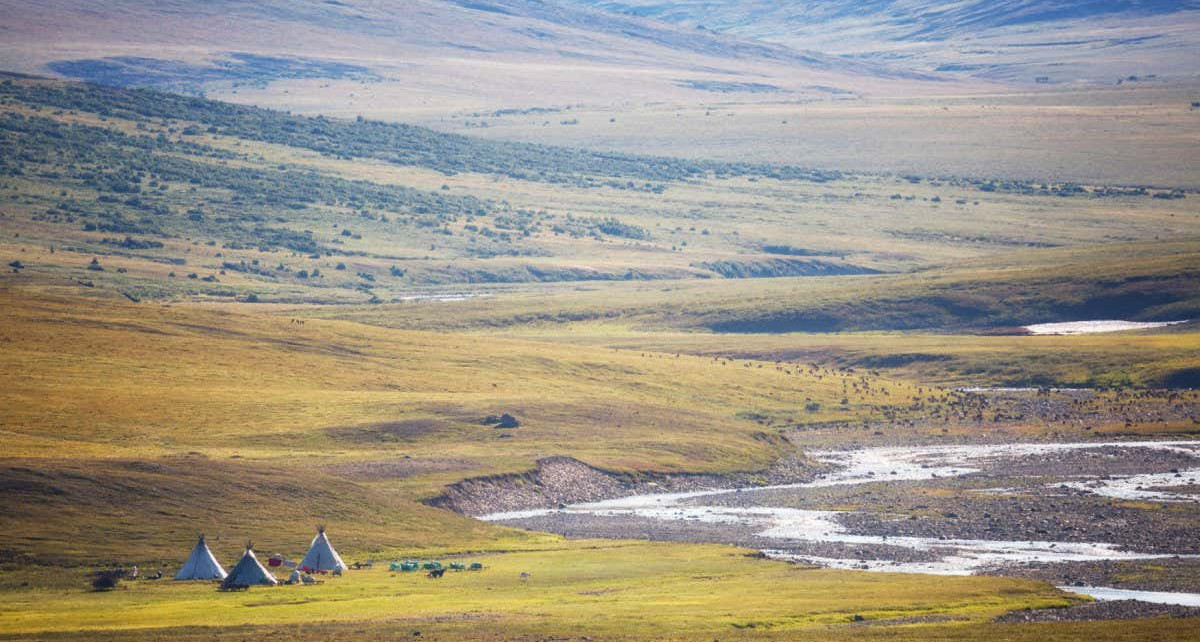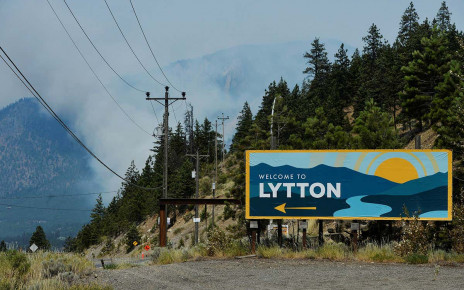[ad_1]
Melting permafrost in Russia’s Yamal peninsula (pictured) has exposed nomadic reindeer herders (below) to anthrax Elena Shchipkova/Alamy 
IN NOVEMBER 2019, the US National Academies of Sciences, Engineering and Medicine held a workshop to discuss an emerging disease threat. Not covid-19: they were a couple of months too early for that. Instead, they were trying to figure out what to do about microorganisms trapped in glaciers, ice sheets and permafrost, which will be released as the world warms and the ice thaws.
During the meeting, Alexander Volkovitskiy from the Russian Academy of Sciences recounted an alarming incident. It took place in 2016 on the Yamal peninsula on Russia’s northern coast where local people herd hundreds of thousands of reindeer. That summer, temperatures were unseasonably warm and some of the permafrost thawed. The bacterium that causes anthrax – which had been present on the peninsula for over a century – emerged from the soil and spread like wildfire. Before the outbreak was brought under control, more than 2000 reindeer had perished. Dozens of people also caught the disease, including an unnamed boy who died.
This story could be a harbinger of what is to come. As Earth’s icy regions thaw, long-dormant microbes will inevitably emerge. The organic matter in permafrost is teeming with them, and even glaciers and ice sheets aren’t the pristine environments once imagined. How likely is it that these microbes – some of which have been trapped for millions of years – will defrost and come back to life? If they do, what risk could they pose to humans? Might we even be exposed to ancient diseases that once infected Neanderthals and Denisovans? These are the questions we need to answer if we are to combat this latent threat.

Alexander Lutsenko/Alamy
About 10 per cent of Earth’s surface is covered with ice and snow. The great ice sheets of Antarctica and Greenland span 15.7 million square kilometres between them. And there are huge rafts of floating sea ice. Hundreds of thousands of glaciers slide imperceptibly slowly down mountainsides and valleys. Meanwhile, the northern hemisphere alone has 23 million square kilometres of permafrost, soil that stays below 0°C for at least two consecutive years, mostly in Siberia, the Tibetan plateau and the far reaches of North America. Climate change is melting it all. Greenhouse gas emissions have already warmed the planet by 1.1°C. In the Arctic, warming is at least twice and possibly three or four times that. Arctic sea ice is shrinking and will probably decline to less than a million square kilometres at least once by 2050. Glaciers are retreating ever further up their valleys. And the ice sheets of Antarctica and Greenland are slowly falling apart at the edges. Anything stored in melting ice, snow and permafrost is going to come out. So we need to know what microbes are in there.
“We might even be exposed to ancient diseases that once infected Neanderthals”
One of the first attempts to find out took place just over a century ago. The Australasian Antarctic Expedition of 1911 to 1914 was a difficult affair in which two team members died and a third had a mental breakdown. But the expedition’s chief doctor, Archibald McLean, succeeded in growing cultures of bacteria, fungi and protozoa from Antarctic ice. Even when he dug more than 2 metres down into the ice, he found life. McLean described his findings in the journal Nature in 1918. With considerable foresight, he suggested that the microbes were carried to Antarctica on winds and fell to the ground in snowflakes. When they reach the icy surface, he wrote, “the frozen organisms… commence a new life-history”.
Pathogens on ice
Since then, it has become clear that snow and ice can contain thriving communities of microscopic life. For example, in 2013, Trista Vick-Majors at Michigan Technological University was part of a team that drilled into Lake Whillans, which lies 800 metres beneath the surface of the West Antarctic ice sheet. “I thought we were going to be lucky to measure anything,” she says. “There was a lot more going on there than we expected.” Subsequent studies revealed entire ecosystems of bacteria and other microorganisms with diverse lifestyles all living together, despite the cold and darkness.
Perhaps we shouldn’t be surprised: Lake Whillans is made of liquid water, even if it is in a rather extreme site. When temperatures are within a few degrees of 0°C, many microbes can survive. For example, on glaciers in the Andes mountains in South America, where there are trickles of water between the ice crystals, Pamela Santibáñez at the Ministry of Science, Technology, Knowledge and Innovation in Chile, has found multitudes. “I can see bacterial activity in between the snow and the ice,” she says.
However, as you dig deeper into ice sheets – into layers that are thousands of years old and far colder than 0°C – life becomes sparser. Santibáñez and her colleagues also looked for microbes in the West Antarctic Ice Shelf Divide ice core, which contains ice laid down over 68,000 years. Concentrations of microbes varied over the millennia, with shifts following changes in the climate. What’s more, microbes in older layers were badly damaged. “Cells that have been in the ice for 25,000 years or 30,000 years, at -30°C, they are in really bad shape,” says Santibáñez.
A melting glacier in Patagonia (pictured) and disturbed permafrost in Russia (below) may both yield disease-causing microbes Shutterstock/Mizzick
This carries a reassuring message: although we can detect microbes in ice that is millennia old, there are few of them and they aren’t exactly thriving. This doesn’t, however, mean that nothing survives. In a 2007 study, researchers managed to grow bacteria from Antarctic ice that was up to 8 million years old. Fortunately, those that endured weren’t ones that make people ill. Indeed, bacteria that infect humans are adapted to live at our body temperatures, so it is highly unlikely that they would survive for long periods below zero.
The same is true for fungi. Some 300 fungi are known to be pathogenic to humans, including Cryptococcus neoformans, which can cause dangerous lung infections. Fungi have been found in ice, from Greenland and Svalbard in the north to Antarctica in the south, and in the slush left behind when glaciers retreat. What’s more, ice from Antarctica has yielded fungi that can be grown in the lab. But again, the quantities are tiny and they weren’t species that are dangerous to us.
This pattern holds for glacier ice too, even though it is often younger and less cold than ice sheets. “Glaciers are the cleanest places on this planet,” says Lonnie Thompson at Ohio State University, who has spent decades exploring these rivers of ice. “When we’re in the field, we drink the meltwater from those glaciers. To date, none of our field team has had any issues from drinking that water.”
Viruses in the freezer
So it looks as if we needn’t worry too much about such microbial life emerging from ice sheets and glaciers. But what about viruses, those tiny structures that are only ambiguously alive?
In 1999, researchers identified a virus that infects tomatoes and other plants in 140,000-year-old glacier ice from Greenland. Five years later, a second group suggested that ice might act as a reservoir for pathogenic viruses including influenza A, caliciviruses that cause gastroenteritis, and certain enteroviruses (the group that includes the polio virus). There was little evidence to back up this idea and other studies are more reassuring. And, although an analysis of very salty Arctic water found plenty of viruses, the majority specialised in infecting bacteria and posed no risk to people. Similarly, last year Thompson’s group identified a range of viruses in ice cores from Tibet, where the ice was as much as 15,000 years old. The majority were infecting bacteria. “On the warmer glaciers, you can have microbes and viruses growing on the surface,” says Thompson. The bacteria are species that can survive in the cold, and the viruses parasitise them. “It’s an ecosystem.”
Compared with bacteria, there have been far fewer studies of viruses in ice. But we do know that they are blown there by the wind, and also that viruses are only contagious when present in large numbers. Vick-Majors finds these facts heartening. “There could be a couple of human pathogens in that package of air that landed there,” she says. “I just wouldn’t expect there to be enough of them to be a threat.”
Disturbed permafrost in Russia Denis Kozhevnikov/TASS/Alamy
Even if microorganisms being released from glaciers and ice sheets are unlikely to make us ill, they aren’t completely innocuous. “They’ll be going into river systems,” says Karen Cameron at the University of Glasgow, UK. “They’re going to be buried within build-up of sediments and organic matter in lakes and downstream fjord environments and near-shore environments.” She has shown that meltwater from the Greenland ice sheet carries microbes far downstream, and that such microbes may well remain active in their new homes. Many of these organisms are rare, so they aren’t well studied, and it is hard to predict what they will do. “We really don’t have a sense of how the ecology is going to change and what are the consequences of that ecological change,” says Cameron.
Nevertheless, at this point, you may be wondering why the US National Academies are worried about diseases emerging from frozen regions. The thing is, while ice is pretty safe, permafrost isn’t. Organic matter such as soil is a much more congenial environment for pathogenic microbes, so permafrost is likely to contain all sorts of nasties. The 2016 anthrax outbreak in Russia is just one example. Human remains exhumed from frozen ground in Alaska have yielded the complete genome of the 1918 Spanish flu virus. A variola virus, related to the one that causes smallpox, was found in a 300-year-old Siberian mummy. And 700-year-old frozen caribou faeces turned out to contain genetic traces of two viruses, albeit not ones that infect us.
A class of microbes known as giant viruses have also turned up. In 2014, a team led by Jean-Michel Claverie at Aix-Marseille University in France found them in Siberian permafrost. These pithoviruses were different from most known viruses – much larger and with more elaborate genomes – and had remained intact in the ice for 34,000 years. They pose no danger to us, because they infect single-celled animals called protozoa. But their Stone Age origin raises an intriguing possibility that thawing permafrost could expose people to pathogens that infected now-extinct ancestral humans who once lived in the region (see “Neanderthal colds and Denisovan flu”).
“Researchers have grown bacteria from 8-million-year-old Antarctic ice”
Claverie’s team has found other viruses too – or at least their genes – in studies looking at the genetic material of whole communities of organisms. “When we do metagenomics, we do see sequence signals corresponding to regular viruses,” he says. Some of these are distinctly unwelcome, including poxviruses and African swine fever virus. “We see many classical viruses in terms of sequence,” says Claverie. “But of course we don’t try to revive those, because that would be dangerous and silly, and we don’t want to be part of the next pandemic.” Nevertheless, the real risk, he argues, is that dangerous viruses might accidentally escape from permafrost.
Parts of the frozen north are now being opened up, Claverie says. For example, in Siberia, opencast coal mines are sometimes dug close to people’s homes. This entails removing layers of permafrost that can be hundreds of thousands of years old. “You don’t know what is there,” he says. This is all being done in the open, not in some biosecure laboratory. “Here is the real danger.”
The many pathogens in permafrost include anthrax bacteria Cavallini James/BSIP/Science Photo Library
The National Academies agree. Delegates at the 2019 meeting concluded that we need increased disease surveillance in the Arctic to spot any outbreaks as quickly as possible and nip them in the bud. This is basic public health practice, but the challenge will be to get the systems up and running in remote areas, where the Indigenous people are sometimes suspicious of Western medicine.
For most of us, the thing to do is to keep this in perspective. The danger is real and needs dealing with – but it isn’t likely to herald the end of the world. “I don’t think that the current thinking is that some global pandemic is just going to thaw out from the Arctic and spread around the globe,” says Vick-Majors. “But it’s certainly a threat to northern communities.” People living in the Arctic and in places such as Siberia are already seeing their environment melt around them. Now, they face the additional threat of deadly infections. Unless we take action, the 2016 anthrax outbreak could be the first of many.
The quest for life’s origin
Michael Marshall explores the ultimate mystery at New Scientist Live newscientistlive.com/speakers
Neanderthal colds and Denisovan flu
Could melting ice and permafrost expose us to disease organisms that infected now-extinct ancestral human groups? It is a dramatic idea, but not an impossible one. Neanderthals and Denisovans were closely related to us and it is likely that early modern humans were afflicted by some of the same pathogens, including those that cause the common cold and cold sores.
A tiny quantity of bacteria or viruses in melting ice wouldn’t pose a significant risk. The real danger would come if a well-preserved body thawed out of permafrost and released lots of infectious material. That seems unlikely. Although Denisovans lived in Siberia and Tibet, their known remains are very sparse and, to date, include nothing more substantial than a jawbone. Neanderthal remains are numerous, but they come mostly from far outside the permafrost zone. Besides, no bodies with preserved flesh have yet been found.
That said, we can’t rule it out. In 2016, a mummified wolf pup was found in thawing permafrost in Canada, and it turned out to be 57,000 years old. Neanderthals are thought to have survived until around 40,000 years ago and Denisovans until about 50,000 years ago. So it is possible a frozen hominin corpse is out there somewhere waiting to emerge from the freezer.
More on these topics:
[ad_2]
Source link




